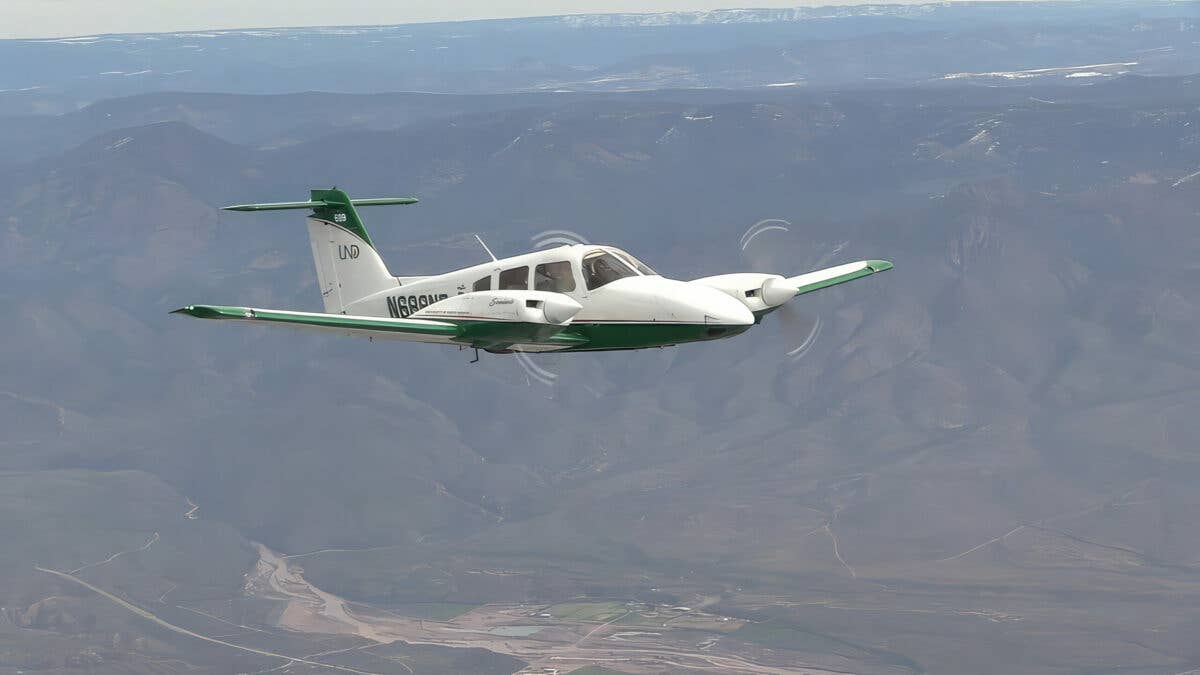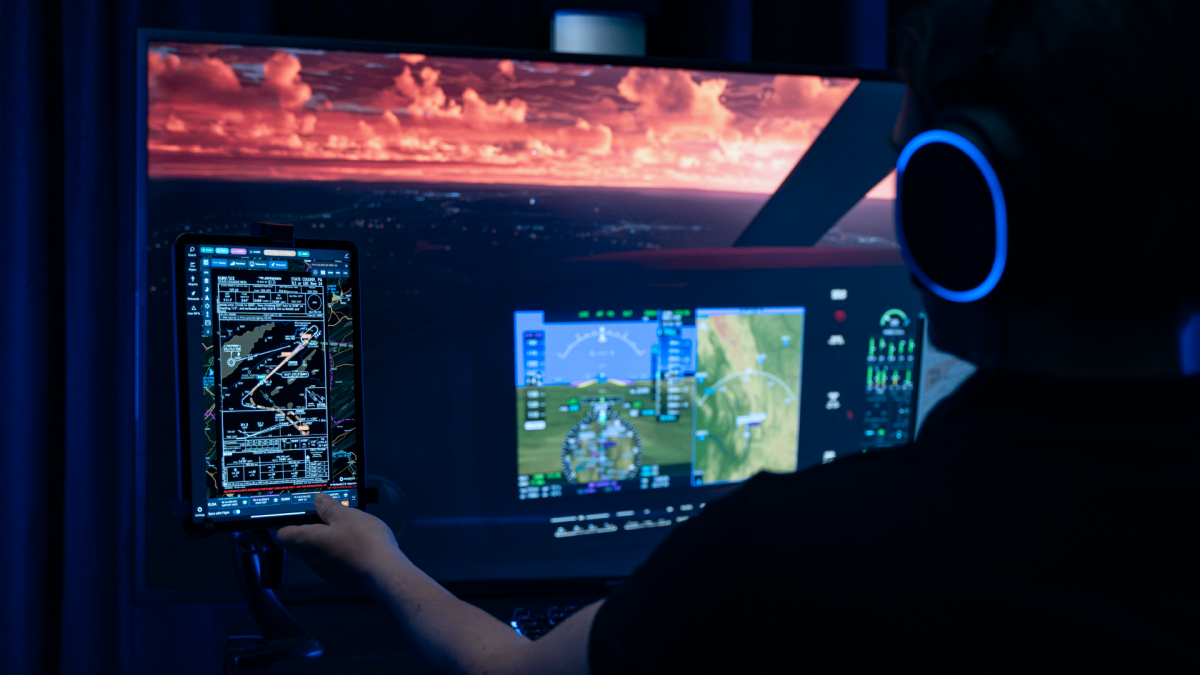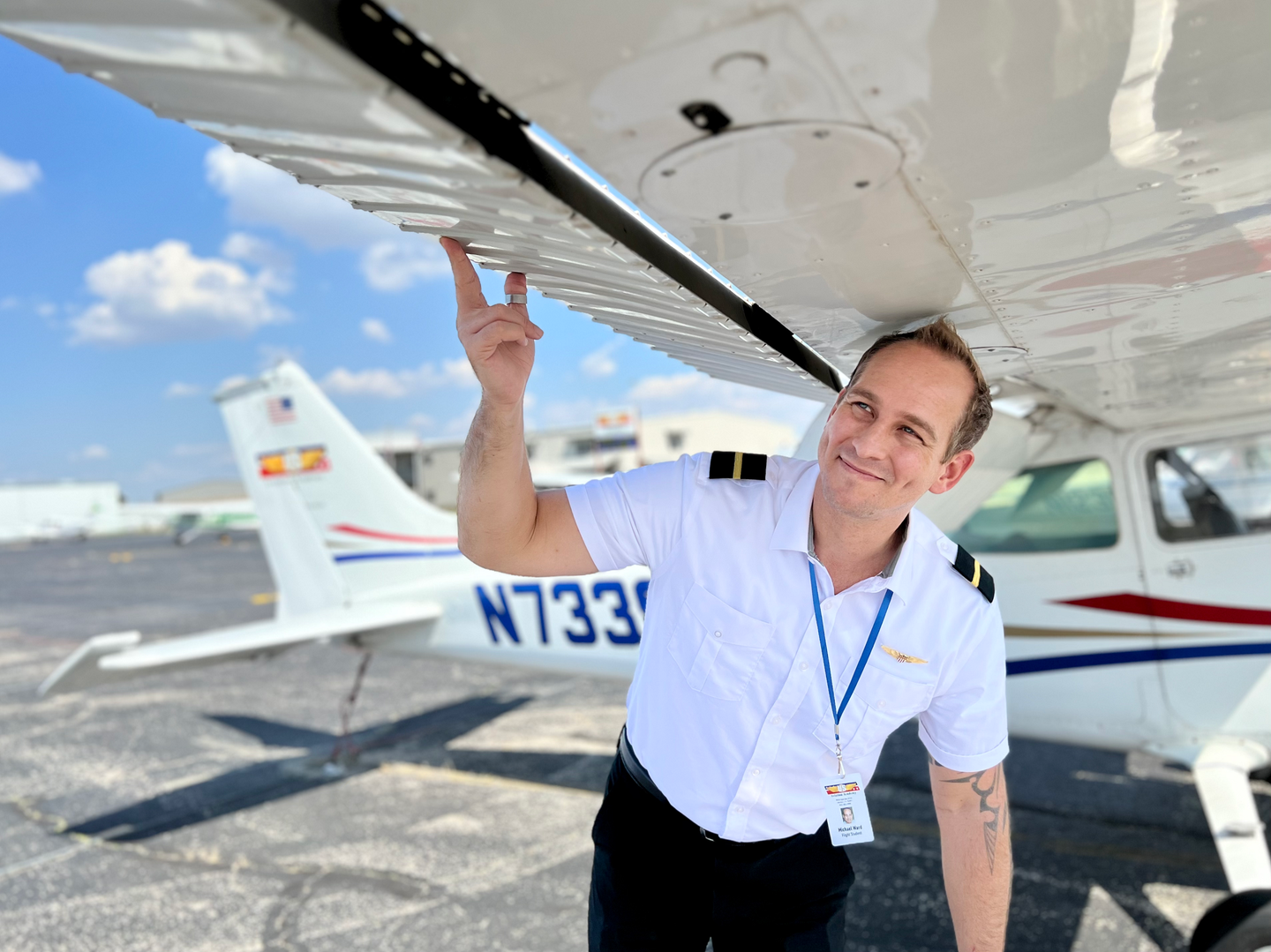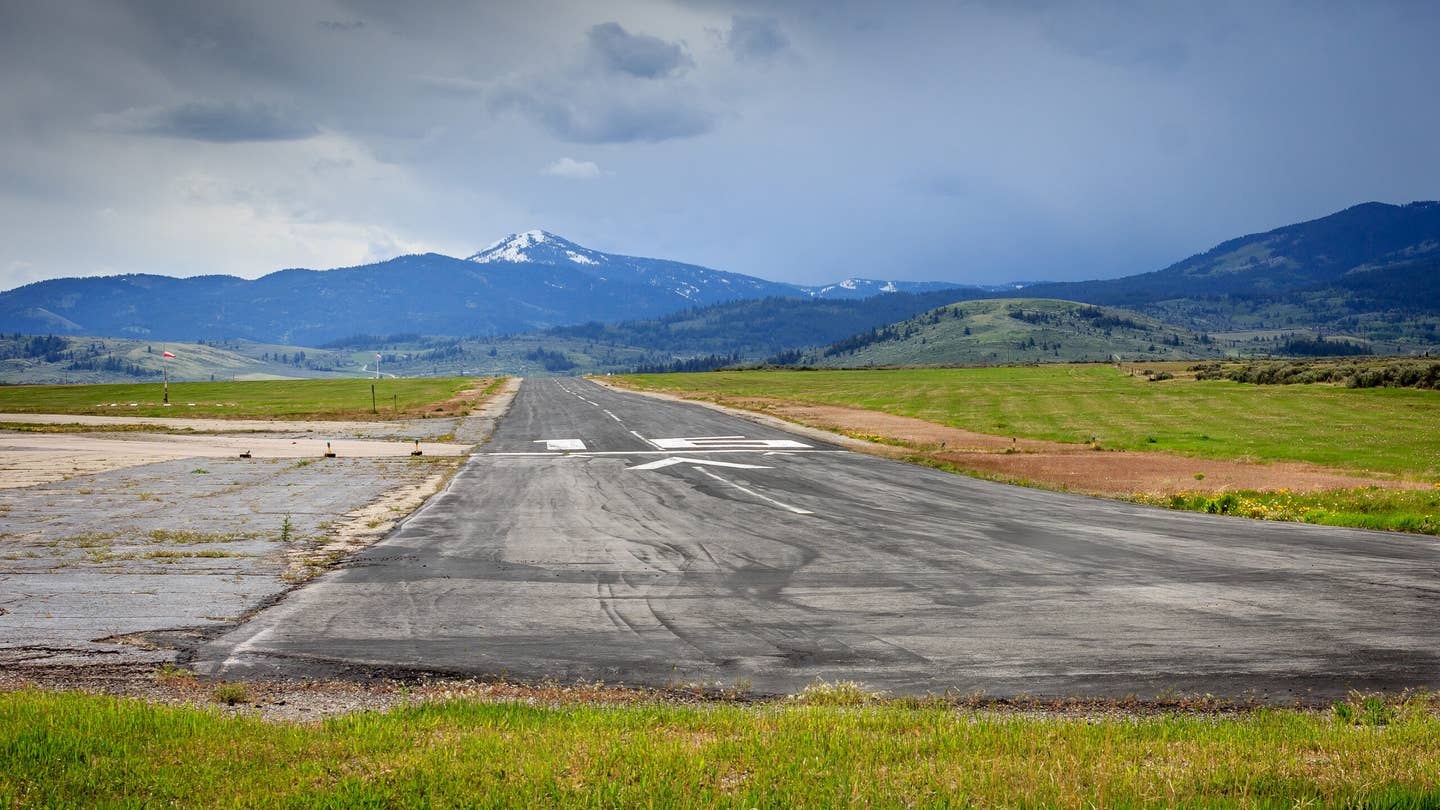About UND Aerospace Foundation Flight Training Center
Home to one of the first accredited aviation programs in the United States and boasting one of the largest civilian aircraft fleets in North America, the John D. Odegard School of Aerospace Sciences campus in Grand Forks maintains an industry-leading reputation in aerospace education and research.

Unique training environments only found in Arizona. [UNDAF Marketing Team]
When choosing a college for an aviation degree, a name that continually represents quality and tradition associated with flight training is the University of North Dakota. Home to one of the first accredited aviation programs in the United States and boasting one of the largest civilian aircraft fleets in North America, the John D. Odegard School of Aerospace Sciences campus in Grand Forks maintains an industry-leading reputation in aerospace education and research.
Smaller and more personalized, but still offering the same industry-leading standard of flight training quality with its own pilot training programs, is UND Aerospace-Phoenix, the ab initio school owned by the UND Aerospace Foundation, the affiliate, nonprofit organization of the university that operates the UND Aerospace Foundation Flight Training Center.
“When students look around for a school to obtain their aviation credentials, there is no better value,” says Chuck Pineo, CEO of the UND Aerospace Foundation. “With us, you get a top-notch entity with a great reputation at a reasonable price. For me, that is what I’d be looking for as a student or as a parent—a place that will create a successful professional.”
Located at Phoenix-Mesa Gateway Airport (KIWA) and operating for nearly three decades, UND-Phoenix is dedicated to both academic based and accelerated flight training options at an affordable price.
The flight school is located on the Chandler-Gilbert Community College (CGCC) campus. With the UND partnership, students enrolling at CGCC are afforded opportunities to join the workforce much quicker while still reaping the benefits of UND’s curriculum and Part 141 FAA training standards.
UND Service with a Personal Phoenix Touch
Rex Ginder, associate director of Phoenix Flight Operations, has worked to grow and enhance the Arizona operations since 2007. A UND graduate, he manages the fight school, facilities, and relationship with the community college.
“The Odegard School of Aerospace Sciences has been around since 1968,” Ginder says. “It is a household name when it comes to training. It is known for the collegiate presentation of aviation, not just being a flight school and not just making pilots. We really like to make aviation professionals. We want our students to be well rounded, possess a little more in-depth knowledge and skills than other folks. That is where we feel we have a competitive edge.”
The UND-Phoenix program currently has approximately 150 students enrolled in the accelerated path program, where they obtain all FAA credentials without traditional degree requirements and complete training in a much shorter time frame, and 100 students in the collegiate program, where they enroll in CGCC’s academic program and the UND Aerospace Foundation provides the flight training.
The accelerated program allows UND-Phoenix students to obtain FAA credentials and become a CFI in less than 12 months. And for those students looking for a more traditional college experience that takes advantage of UND’s in-depth aerospace classroom training, a two-year associate degree is offered. Once CGCC students complete the two-year program, they can continue on to receive a four-year aviation degree at UND as well.
Traditional College Program vs. Accelerated Path
Through CGCC, UND offers a credit-bearing associate degree in applied science (airway science technology). This is a term-based, six-semester program where after two years students earn their degree and flight instructor certificate.
“This has a nice smattering of courses in addition to the general education requirements,” Ginder says. “It included aviation safety, aviation meteorology, crew resource management, advanced aircraft systems, introductory unmanned aircraft systems, along with ground school and flight labs for a six-semester associate degree program.”
The accelerated program is an option for students who already have a college degree and are looking for a career change.
“Rather than going back and taking all those general requirements and academic courses that are nonaviation, students could jump right in and take the FAA 141 curriculum,” Pineo says. “So a student could jump in, obtain their private pilot [certificate], and not worry about all the other courses significantly reducing the amount of time required.”
The accelerated program will have three start times in 2024—February, June, and October. The college program runs on traditional academic start times for the 16-week terms, usually the third week of August, second week of January, and mid-May for the summer semester.
With the accelerated program, students typically meet four to five times a week instead of the schedule of a traditional college environment (two to three times a week), allowing them to complete all FAA credentials and become a CFI in less than 12 months.
“That gets you into the workforce,” Pineo says. “You’ll still need to build your time to be eligible to go work for the airlines or even a corporate-type employer. But a lot of time we will hire you. If we have demand for flight instructors, we will certainly hire you. If we don’t, someone else will hire you and you can build your time. So you can build your time in a year or less from the time you start the program.”
Modern, Standardized Fleet
Possessing the largest training fleet in the world, UND Aerospace certainly checks all the boxes when it comes to offering students extensive aircraft to learn in. UND-Grand Forks, for example, flies in the neighborhood of 120,000 training hours a year while the Phoenix campus adds another 40,000 hours to the mix. “You need a lot of airplanes to support that level of flying, and you need good people to maintain and operate those airplanes,” says Ginder.
Students at Chandler-Gilbert Community College also fly a world-class fleet of training aircraft, including standardized glass cockpit instrumentation, operated and maintained by UND Aerospace.
“We have all the modern tech. It’s gorgeous,” says Ginder. “It really helps us keep pace with what UND is doing. So when they make a change, we just do it down here as well.”
Ginder points out that the average fleet age of the 24 Piper Archers located at KIWA is between four and five years old. The Piper Archer, one of the most reliable airplanes in collegiate flight training, is used for the majority of the students' flight training from private pilot through flight instructor certification. With a 180 hp Lycoming engine and an advanced Garmin G1000 NXi avionics suite that includes ADS-B traffic awareness, the airplane is modern and very capable for training.
The school also flies three multiengine Piper Seminoles, used to teach advanced operations and procedures. Together, the Piper Seminole and Archer complement each other, allowing students to seamlessly transition between the two airplanes. In addition to the Garmin G1000 NXi avionics suite, the Piper Seminole boasts a Garmin two-axis autopilot that prepares students for the advanced operations in today's aviation industry.
In addition, one Cessna 172 is also available for spin training as part of the CFI course. Two Archer and two Seminole simulators are also present on campus.
Community College Partnership
Located on the site of the former Williams Air Force Base, CGCC provides UND-Arizona students access to a full-service, modern campus that offers a full slate of general education requirements. The campus right on the airport contains a library, computer lab, cafe, and student union area.
UND on-site facilities include preflight planning rooms, briefing rooms, and a dispatch area connected to a hangar where the airframe and powerplant lab resides. All told, the flight operations maintain 10,000 square feet of office and classroom space, 14,000 square feet of hangar space, and a 3,000-square-foot facility that houses the school’s four simulators and additional classroom and briefing room space.
“The community college is a strong partner because they already have an interest in aviation,” Ginder says. “They have an unmanned aircraft systems program. They have an airframe and powerplant Part 147 certification program. Those both fit in the associate degree model. We were not a new entity in bringing in a flight training program to the college. They are used to dealing with the different rigors of aviation, FAA [requirements], and the student behaviors that come along with that. So they are naturally a good fit, and I think that is why our partnership has been strong for so long.”
“Chandler-Gilbert [CC], because they started with an aviation emphasis and very soon added us as the flight training provider, understands what it means to flight train in this specific way,” Ginder says. “Our partnership offers us the flexibility within a term-based semester program. They have been responsive with curriculum changes if we need to update material to more modern coursework. And we are one of only a few programs in the state [of Arizona] that supports the post-9/11 GI Bill for veterans beyond the private pilot certificate.
An added benefit is classroom instruction by UND staff. On the day FLYING interviewed Ginder, he had just taught an aircraft systems course before the interview.
“[Some of the supporting coursework the community college will teach]...mainly it is staffed by my team,” he says. “You are getting folks that are regularly flying. You are not getting a professor who doesn’t actively fly. You are getting folks who are engaged in the training, in the aircraft, teaching in the classroom.”
Synergy with UND Provides Students a Higher Level of Depth
Both UND-Grand Forks and UND-Arizona share the same Part 141 Certificate and Part 145 repair certificate. This translates into an extra level of structure and, ultimately, success for students.
“Part 141 provides a higher degree of structure, and it’s implied that it provides a higher degree of discipline, preparedness, and depth of the program,” Ginder says. “Students can expect to have a full training course outline and possibly multiple syllabi…that state lesson by lesson: What we are doing today? When we fly tomorrow, what are the items I’ll be asked to perform in the air? What is the depth and level of knowledge expected in the air? Part 141 provides that structure.”
Ginder adds that the Part 141 examining authority also significantly aids the program.
“It keeps the students moving. They are not sitting around waiting for stage checks,” he says. “With it, FAA holds us to a higher standard—for example, on our students' first attempt percentages. In other words, do they pass their check rides and airman's knowledge tests the first time around? So, by being held to those standards, there are some other things that are afforded to us, such as exercising examining authority under Part 141. What that means is we do not work with designated pilot examiners from the FAA. So we don’t have to seek out individuals to get check rides. The FAA grants us, by the way we conduct our school and our business, the ability to issue our pilot certificates without dealing with the designated pilot examiner (DPE ) or the FAA check ride portion.”
Best Value on the Market
UND-Phoenix has obtained a solid reputation for consistently delivering quality and value to its students and producing in-demand graduates who have their choice of any and all job opportunities.
“Our students are picking where they want to go,” Pineo says. “We have students going to Allegiant, Pinnacle, SkyWest, Mesa, Republic—all the major regionals [airlines] and all the corporate-type aviation companies.”
Says Ginder: “We have not had anyone not get their first choice accepted on where they want to go work. Whether that is from the collegiate side or the accelerated program being placed directly into wherever they want to go. It is not, ‘I hope I get this job.’ It’s, ‘I applied for this job. I got it,’ whether that is a corporate operator or someplace such as Frontier, SkyWest, or another regional.”
While every flight school represents a substantial investment, UND-Phoenix offers a significant value.
“If you compare our pricing with other accelerated programs, you’ll find that we are probably in the midrange of expense to the student,” says Pineo. “But if you look around the industry at our reputation and our graduates, we are probably in the high range. Sometimes your track record speaks for itself. And I certainly like to think that when you look at our graduates—how successful they are and how desirable they are to hire based on the reputation of the program—that says a lot.”
Options Abound with UND Aerospace Foundation Flight Training Center
UND-Phoenix has created a flight training center that perfectly blends academic opportunity with the ability to quickly join the workforce seniority pool.
Add in the fact that all coursework at CGCC transfers to UND and the flight school gives students interested in furthering their academic aviation study a multitude of options. For example, students can start working on an aviation studies degree, which is available online with UND’s main campus, while working as a flight instructor.
With a perfect blend of academic rigor, significant value, and access to the largest training fleet in the world, UND-Phoenix provides one of the best returns on investment of any fight school.
UND Phoenix by the Numbers
Phoenix-Mesa Undergraduate & Accelerated Programs
5865 South Sossaman Road
Mesa, Arizona 85212
info@undaerospace.com | 480-809-4499
Associates Degrees Offered:
- Airway Science Technology, Flight Emphasis
- Unmanned Aircraft Systems
Certificates Offered:
- Certified Flight Instructor Instrument Airplane Rating
- Unmanned Aircraft Systems
Accelerated Degree Costs:
- Accelerated program total cost from an ab-initio start (no private pilot certification): $102,186.90
- Accelerated cost if you come in with private pilot certificate (-$17,622.70) = $84,564.20
This program is private through MEI and includes ground school costs.
CGCC Degree Costs:
- Chandler Gilbert Community College ab initio: $84,740.90 + Tuition of 75 credits, ($6,375) = $91,115 total (approximate for the associate’s degree and flying)
- Chandler Gilbert Community College if you come in with private pilot certificate: (-$17,622.70) = $67,118.20
This program covers private through CFI single-engine.
Average Degree Hour Requirements
- Private pilot course averages 50-55 hours.
- Instrument course averages 35 hours, in the beginning.
- Multiengine add-on is 14-20 hours.
- CFI certificate is a 25-hour course.
- Instrument instructor averages 25 hours.

Subscribe to Our Newsletter
Get the latest FLYING stories delivered directly to your inbox

![[PILOT AND SNELLEN CHART PIC]](https://www.flyingmag.com/uploads/2022/11/2022-FlyingMag.com-Native-Advertising-Main-Image--scaled.jpeg?auto=webp&auto=webp&optimize=high&quality=70&width=1440)




